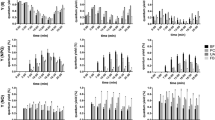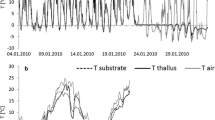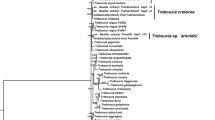Abstract
Lichens form an important part of the biodiversity in terrestrial ecosystems of Antarctica where they represent the dominant vegetation. Previous studies on the genetic diversity of photobionts of lichens have indicated that clade S Trebouxia photobionts are the most widespread in continental Antarctica, predominantly in macrolichens. For the first time, a comparative study of the physiology of a variety of isolated Antarctic lichen photobionts (genus Trebouxia) was performed. Photosynthetic activity was examined by chlorophyll a fluorescence and correlated with freezing and desiccation under laboratory conditions and photosynthetic pigments were quantified in response to desiccation. Data were obtained from photobionts collected from the Antarctic regions of North Victoria Land, Coal Nunatak and Rothera Point, as well as from a European site (Gotland, Sweden). While the isolated algae reacted individually to stress treatments, they were highly susceptible to desiccation stress but could rapidly recover from freezing. Photobiont-specific physiological adaptations are considered to explain the dominance of clade S Trebouxia photobionts.





Similar content being viewed by others
Abbreviations
- A:
-
Antheraxanthin
- chl FY:
-
chlorophyll fluorescence yield
- DEPS:
-
de-epoxidation status of the xanthophyll pool
- F0 :
-
minimum chl FY in the dark-acclimatized state
- FM :
-
maximum chl FY in the dark-acclimatized state
- FV/FM :
-
maximum quantum yield of PS II
- HPLC:
-
high performance liquid chromatography
- NPQ:
-
non-photochemical quenching
- PAM:
-
pulse-amplitude modulation
- PS II:
-
photosystem II
- ROS:
-
reactive oxygen species
- SE:
-
standard error of the mean
- TOM:
-
Trebouxia organic medium
- V:
-
violaxanthin
- Z:
-
zeaxanthin
References
Ahmadjian V (1967) A guide to the algae occurring as lichen symbionts: isolation, culture, cultural physiology and identification. Phycologia 6:127–160
Barták M, Váczi P, Smykla J (2007) Low-temperature limitation of primary photosynthetic processes in Antarctic lichens Umbilicaria antarctica and Xanthoria elegans. Polar Biol 31:47–51
Beck A (2002) Selektivität der Symbionten schwermetalltoleranter Flechten. PhD thesis, München
Block W (1996) Cold or drought – the lesser of two evils for terrestrial arthropods? Eur J Entomol 93:325–339
Brandt A (2011) Genetische Diversität der Flechtenalgen von NorthVictoria Land, Antarktis. Diploma thesis, HHU Düsseldorf
De Vera J-PP, Ott S (2010) Resistance of symbiotic Eukaryotes. In: Seckbach J, Grube M (eds) Cellular origin. Life in extreme habitats and astrobiology. Symbiosis and stress. Springer, Dordrecht, pp 595–611
Demmig-Adams B, Adams WW (1996) The role of xanthophyll cycle carotenoids in the protection of photosynthesis. Trends Plant Sci 1:21–26
Ertl L (1951) Über die lichtverhältnisse in laubflechten. Planta 39:245–270
Fernández-Marín B, Balaguer L, Esteban R, Becerril JM, García-Plazaola JI (2009) Dark induction of the photoprotective xanthophyll cycle in response to dehydration. J Plant Physiol 166:1734–1744
Fernández-Marín B, Becerril JM, García-Plazaola JI (2010) Unravelling the roles of desiccation-induced xanthophyll cycle activity in darkness: a case study in Lobaria pulmonaria. Planta 231:1335–1342
Friedl T (1989) Systematik und Biologie von Trebouxia (Microthamniales, Chlorophyta) als Phycobiont der Parmeliaceae (lichenisierte Ascomyceten). PhD thesis, Bayreuth
Hájek J, Barták M, Dubová J (2006) Inhibition of photosynthetic processes in foliose lichens induced by temperature and osmotic stress. Biol Plantarum 50:624–634
Harańczyk H, Nowak P, Bacior M, Lisowska M, Marzec M, Florek M, Olech MA (2012) Bound water freezing in Antarctic Umbilicaria aprina from Schirmacher Oasis. Antarct Sci 24:342–352
Helms G (2003) Taxonomy and Symbiosis in Associations of Physciaceae and Trebouxia, PhD thesis, Tübingen
Helms G, Friedl T, Rambold G, Mayrhofer H (2001) Identification of photobionts from the lichen family Physciaceae using algal-specific ITS rDNA sequencing. Lichenologist 33:73–86
Honegger R (2009) Ökologische Aspekte der Wechselbeziehung zwischen Pilz und Alge. Rundgespräche Kommission Ökol 36:25–41
Huiskes AHL, Convey P, Bergstrom DM (2006) Trends in Antarctic terrestrial and limnetic ecosystems: Antarctica as a global indicator. In: Bergstrom DM, Convey P, Huiskes AHL (eds) Trends in Antarctic terrestrial and limnetic ecosystems. Springer, Dordrecht, pp 1–14
Kappen L (1973) Response to extreme environments. In: Ahmadjian V, Hale ME (eds) The lichens. Academic, New York, pp 311–380
Kappen L (1993) Plant activity under Snow and Ice, with particular reference to lichens. Arctic 46:297–302
Kappen L (2000) Some aspects of the great success of lichens in Antarctica. Ant Sci 72(3):314–324
Kappen L, Breuer M (1991) Ecological and physiological investigations in continental Antarctic cryptogams. II. Moisture relations and photosynthesis of lichens near Casey station, Wilkes land. Antarct Sci 3:273–278
Kappen L, Lange OL (1970) The cold resistance of phycobionts from macrolichens of various habitats. Lichenologist 4:289–293
Kappen L, Lange OL (1972) Die Kälteresistenz einiger Makrolichenen. Flora 161:1–29
Kappen L, Valladares F (1999) Opportunistic growth and desiccation tolerance: The ecological success of poikilohydrous autotrophs. In: Pugnaire FI, Valladares F (eds) Handbook of functional plant ecology. Marcel Dekker, Basel, pp 121–194
Kappen L, Sommerkorn M, Schroeter B (1995) Carbon acquisition and water relations of lichens in polar regions – potentials and limitations. Lichenologist 27:531–545
Kennedy AD (1993) Water as a limiting factor in the Antarctic terrestrial environment: a biogeographical synthesis. Arct Alp Res 25:308–315
Kosugi M, Arita M, Shizuma R, Moriyama Y, Kashino Y, Koike H, Satoh K (2009) Responses to desiccation stress in lichens are different from those in their photobionts. Plant Cell Physiol 50(4):879–888
Kranner I, Birtic S (2005) A modulating role for antioxidants in desiccation tolerance. Integr Comp Biol 45:734–740
Kranner I, Cram WJ, Zorn M, Wornik S, Yoshimura I, Stabentheiner E, Pfeifhofer HW (2005) Antioxidants and photoprotection in a lichen as compared to its isolated symbiotic partners. Proc Natl Acad Sci USA 102:3141–3146
Kranner I, Beckett R, Hochman A, Nash TH (2008) Desiccation-tolerance in lichens: a review. Bryologist 111:576–593
Krause GH, Jahns P (2004) Non-photochemical energy dissipation determined by chlorophyll fluorescence quenching: Characterization and function. In: Papageorgiou GC, Govindjee (eds) Chlorophyll a fluorescence: A signature of photosynthesis. Springer, Dordrecht, pp 464–495
Lange OL, Kappen L (1972) Photosynthesis of lichens from Antarctica. Antarct Res Ser Antarct Terr Biol 20:83–95
Maxwell K, Johnson GN (2000) Chlorophyll fluorescence – a practical guide. J Exp Bot 51:659–668
Øvstedal DO, Lewis SRI (2001) Lichens of Antarctica and South Georgia. Cambridge University Press, Cambridge
Pannewitz S, Schlensog M, Green TGA, Sancho LG, Schroeter B (2003) Are lichens active under snow in continental Antarctica? Oecologia 135:30–38
Pfeifhofer HW, Willfurth R, Zorn M, Kranner I (2002) Analysis of chlorophylls, carotenoids, and tocopherols in lichens. In: Kranner I, Beckett R, Varma A (eds) Protocols in lichenology. Culturing, biochemistry, ecophysiology and use in biomonitoring, 1st edn. Springer, Berlin, pp 363–378
Richter M, Rühle W, Wild A (1990) Studies on the mechanism of photosystem II photoinhibition I. A two-step degradation of D1-protein. Photosynth Res 24:229–235
Romeike J, Friedl T, Helms G, Ott S (2002) Genetic diversity of algal and fungal partners in four species of Umbilicaria (lichenized ascomycetes) along a transect of the Antarctic Peninsula. Mol Biol Evol 19:1209–1217
Schaper T, Ott S (2003) Photobiont selectivity and interspecific interactions in lichen communities. I. Culture experiments with the mycobiont Fulgensia bracteata. Plant Biol 5:441–450
Schlensog M, Schroeter B (2000) Poikilohydry in Antarctic cryptogams and its influence on photosynthetic performance in mesic and xeric habitats. In: Davidson W, Howard-Williams C, Broady P (eds) Antarctic ecosystems. Models for wider ecological understanding. Caxton Press, Christchurch, pp 175–183
Schlensog M, Schroeter B, Pannewitz S, Green TGA (2003) Adaptations of mosses and lichens to irradiance stress in maritime and continental habitats. In: Huiskes AHL, Gieskes WWC, Rozema J, Schorno RML, van der Vies SM, Wolff WJ (eds) Antarctic biology in a global context. Backhuys Publishers, Leiden, pp 161–166
Schroeter B, Green TGA, Kappen L, Seppelt RD (1994) Carbon dioxide exchange at subzero temperatures. Field measurements on Umbilicaria aprina in Antarctica. Crypto Bot 4:233–241
Schroeter B, Kappen L, Green TGA, Seppelt RD (1997) Lichens and the Antarctic environment: Effects of temperature and water availability on photosynthesis. In: Lyons W, Howard-Williams BC, Hawes I (eds) Ecosystem processes in Antarctic ice-free landscapes. A. A. Balkema, Rotterdam
Schroeter B, Kappen L, Schulz F, Sancho L (2000) Seasonal variation in the carbon balance of lichen in the maritime Antarctic: Long-term measurements of photosynthetic activity in Usnea aurantiaco-atra. In: Davidson W, Howard-Williams C, Broady P (eds) Antarctic ecosystems: models for wider ecological understanding. Caxton, Christchurch, pp 258–262
Valladares F, Sancho LG, Ascaso C (1997) Water storage in the lichen family Umbilicariaceae. Bot Acta 111:99–107
Veerman J, Vasil’ev S, Paton GD, Ramanauskas J, Bruce D (2007) Photoprotection in the lichen Parmelia sulcata: the origins of desiccation-induced fluorescence quenching. Plant Physiol 145:997–1005
Vráblikóvá H, Barták M, Wonisch A (2004) Changes in glutathione and xanthophyll cycle pigments in the high light-stressed lichens Umbilicaria antarctica and Lasallia pustulata. J Photo Biol 79:35–41
Walton DWH (1982) The Signy Island terrestrial reference sites: XV. Microclimatic monitoring, 1972–74. Brit Antarct Surv Bull 55:111–126
Yoshimura I, Yamamoto Y, Nakano T, Finnie J (2002) Isolation and culture of lichen photobionts and mycobionts. In: Kranner I, Beckett R, Varma A (eds) Protocols in lichenology. Culturing, biochemistry, ecophysiology and use in biomonitoring, 1st edn. Springer, Berlin, pp 3–33
Acknowledgments
Special thanks are due to the BGR (Bundesanstalt für Geologie und Rohstoffe), Andreas Läufer and Detlef Damaske for inviting the second author to the expedition GANOVEX X and logistic support. The staff of the Gondwana Station is thanked for their invaluable help. Sample collection during GANOVEX X was financially supported by the Deutsche Forschungsgemeinschaft (Ot 96/15–1), within the framework of the DFG Antarctic Priority Program 1158. Our special thanks are due to Eva Posthoff for her invaluable technical support. The results are included in the doctoral thesis of Andres Sadowsky. Thanks are also due to the anonymous reviewers for their helpful comments.
Author information
Authors and Affiliations
Corresponding author
Rights and permissions
About this article
Cite this article
Sadowsky, A., Ott, S. Photosynthetic symbionts in Antarctic terrestrial ecosystems: the physiological response of lichen photobionts to drought and cold. Symbiosis 58, 81–90 (2012). https://doi.org/10.1007/s13199-012-0198-7
Received:
Accepted:
Published:
Issue Date:
DOI: https://doi.org/10.1007/s13199-012-0198-7




